Is your ZZ Plant soggy and overwatered? Here is how to save an overwatered ZZ plant and how to prevent overwatering it again!
That ZZ plant is a striking addition to your green nook! As a native to the tropics of East Africa, it won’t do you much trouble since it’s one of the most low-maintenance plants out there.
Once you bring it home, place it under indirect sunlight and give it some time to adjust.
Because the tropics of Africa are known to be quite arid, the ZZ has adjusted to living for days on end without water since rainfall didn’t happen too often.
Even in indoor settings, its water requirements are still the same, so you only need to do it once every 2-3 weeks! Told you it was low maintenance!
However, considering you’ve ended up here, it’s possible that you may have an overwatered ZZ plant in your hands.
Apparently, somebody didn’t give you the memo about its watering requirements!
No worries, though; we’re here to help you!
In this blog, we will show you how to prevent ZZ plant overwatering and how to save the one already drenched in water. With your green thumb and our tips, this will be a breeze!
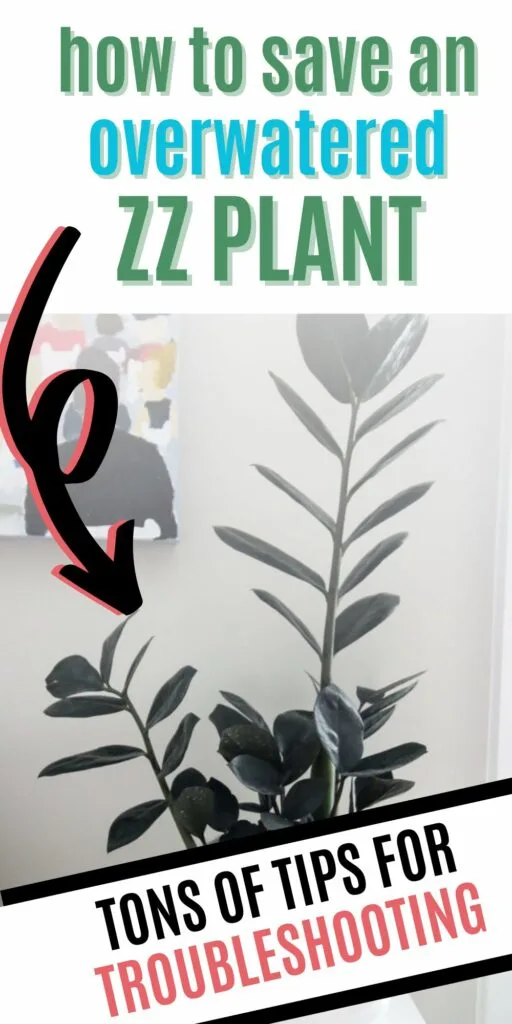
Want more ZZ plant topics?
- Raven ZZ plant care guide
- The Best ZZ Plant Soil
- Why is my ZZ plant getting yellow leaves?
- Why is my ZZ plant not growing?
- Why is my ZZ plant turning brown?
Free printable ZZ plant care guide
Join the (free!) KeepYourPlantsAlive+ community to access this exclusive printable plant care guide! Once you sign up, you can right click & save the JPG care guide. Or keep scrolling for more!
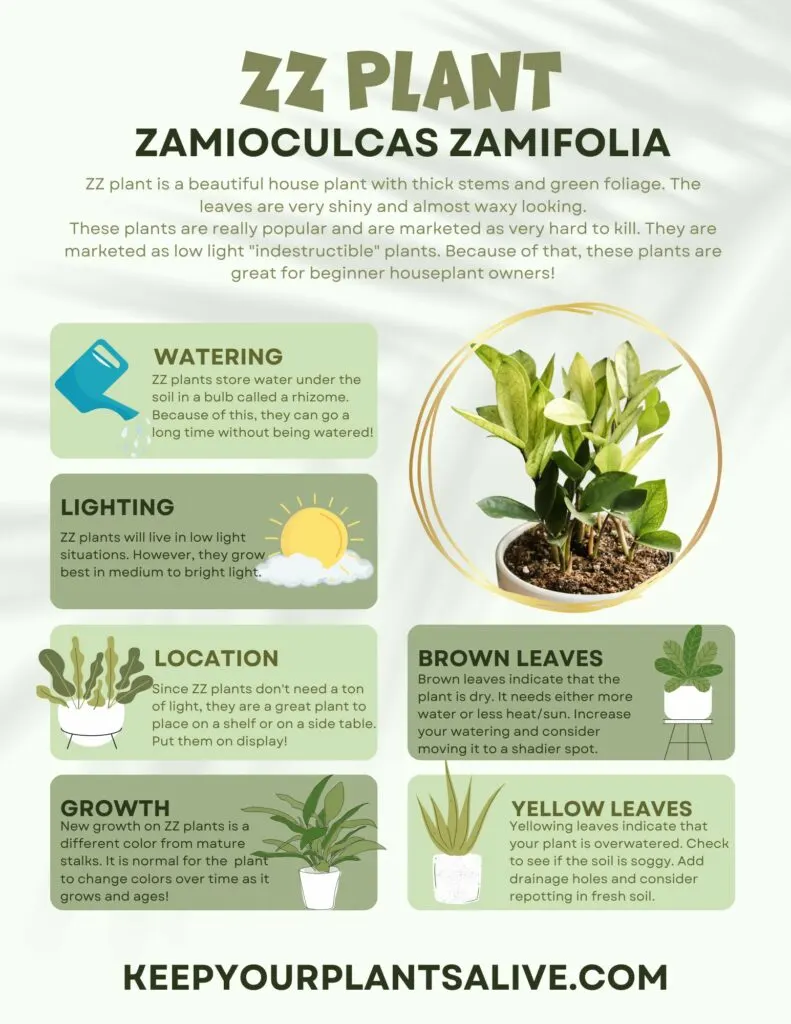
The Paradox of Water: Beneficial and Harmful
To give you a quick bio class reminder, water is an essential part of the functioning of every living organism, including plants, contributing to the optimal performance of vital functions.
Since we’re focusing solely on our green beauties, nutrition, absorption, and photosynthesis cannot happen without water.
But what happens if the watering amount or frequency becomes excessive?
The excess of water leads to its retention at the bottom or in the soil, thus disrupting the balance between water and air. Air circulation and oxygen distribution are hindered.
The vital parts of the plant do not receive oxygen, they lose nutrients, and the entire plant may wither.
Other problems, such as root rot, yellowing, and even death, are possible if the issue isn’t handled quickly.
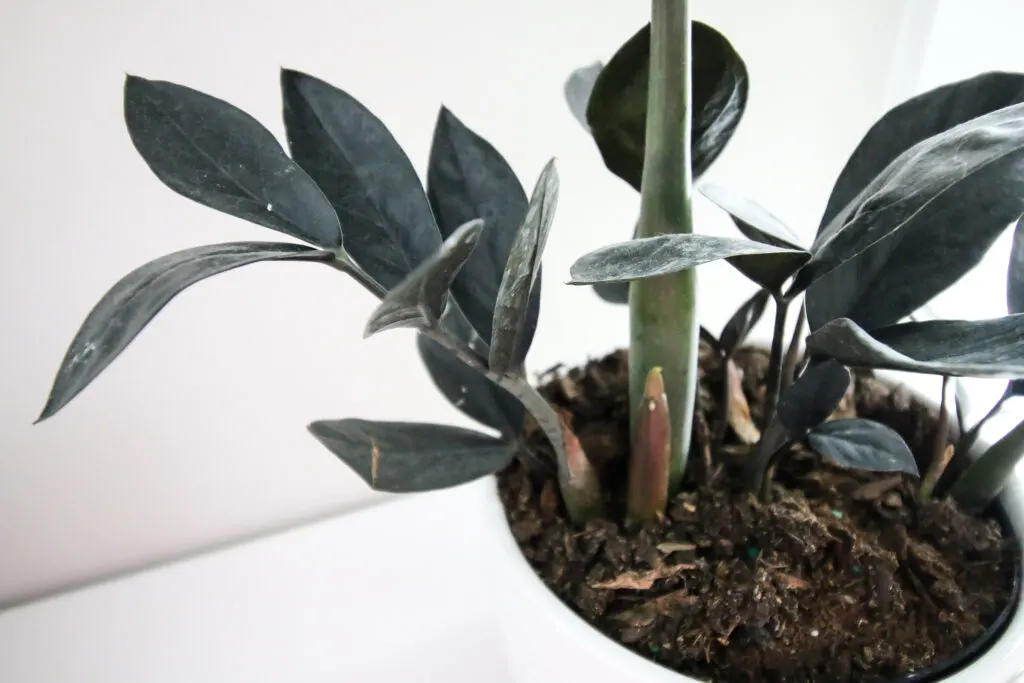
First Aid to Save an Overwatered ZZ Plant
As previously mentioned, you’re not the only one with an overwatered ZZ plant and this mistake is pretty common.
But you need to act fast to prevent this from becoming a permanent problem.
Move your plant to a sunny spot so the soil dries out faster. But still, make sure that it is indirect light or leave it only 2-3 hours a day in direct sunlight.
A ZZ plant that’s overwatered can also benefit from an open window!
The combination of sun and air circulation will help for faster drying.
If you have a bigger pot, you can put components such as perlite, orchid bark, and sand and gently mix the soil on top without damaging the upper part of the root.
If you notice mold on top of the soil, remove it with a wooden stick and move it to a sunny spot.
Remember that this is only a quick fix since we’ll need to look closer into our droopy ZZ plant to see if there is any deeper damage.
Here are all of our tips for how to dry out an overwatered plant!
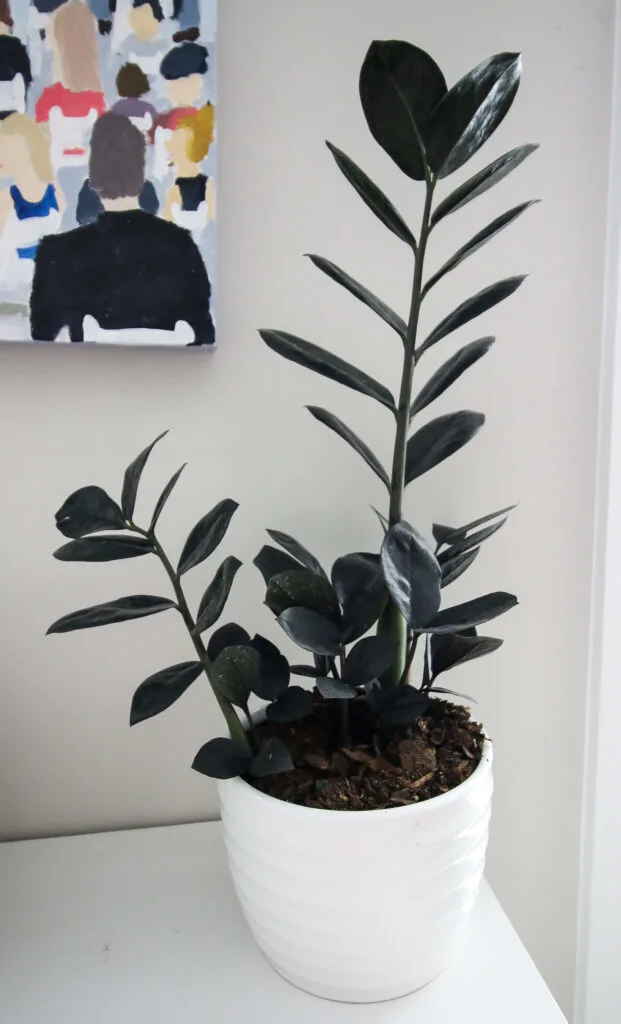
Signs of overwatered ZZ plant
Signs of ZZ plant overwatering will appear relatively quickly, within a week at most. You will be able to notice some of the following changes:
- Yellowing of leaves
- Mushy brown stalks
- Rotting root
- Smelly soil
- Drooping leaves
- Soft leaves
- Falling over
Yellow leaves
The most obvious sign that you have overwatered your ZZ plant is the yellowing of the leaves.
As the roots are trapped in water, they can’t get enough oxygen and don’t have enough nutrients to sustain all of the growth.
The glossy foliage is lost because the root needs to carry nutrients to the leaves. The core may also be rotten and more susceptible to infections and pests.
Brown stalks
The excellent and healthy root produces healthy stalks. If the soil is excessively wet, the root will rot for sure. In turn, the stalks won’t be fed and, as a result, will end up all mushy and brown.
Smelly soil
Does your ZZ plant have an odd smell? Check for mold on the surface. Mold grows in wet places.
If you have been overwatering your plant, there might be some of it creeping into the soil.
If the soil is moldy or stinky, I usually suggest dumping it and planting in fresh soil.
Droopy leaves
One of the signs of overwatering is a droopy ZZ plant, specifically – its leaves. They lose their vigor due to, most likely, root rot.
The root system can no longer transport the necessary substances, and after switching off the neutralizing mechanisms, the leaves show signs of death. T
his process can be reversible if you react quickly – repotting is most often recommended.
Softer leaves
For the same reason, the leaves of the ZZ plant can become very soft. If you notice a lighter color of the leaves or their softening, be careful with watering.
Move the plant to a warmer place to dry out and reduce watering frequency.
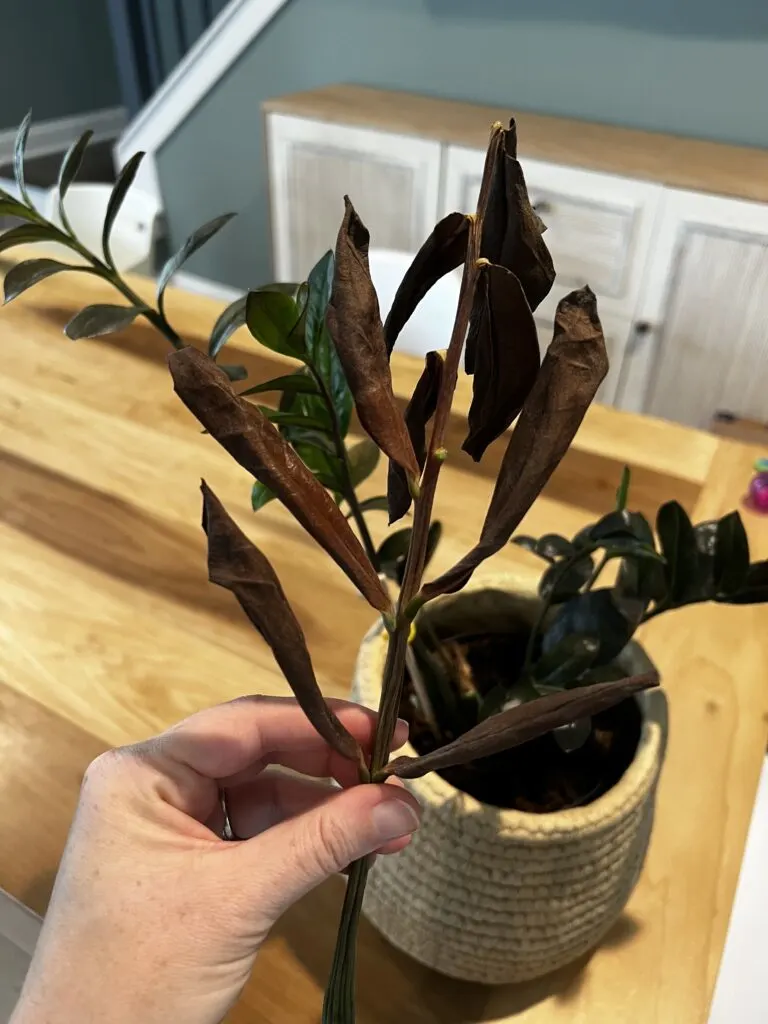
Step how to revive the overwatered ZZ plant
We are offering simple guidelines for rescuing overwatered ZZ plants. Let’s dive in together.
Prepare the ZZ plant for replanting
First, gently dig up the entire plant with a sterile spade without damaging any parts of the roots or bulb.
Clean from the soil, rinse the root with water, and spray it with hydrogen peroxide. Leave to dry for a short time.
Cut the damaged parts
Now, it’s time for a brief analysis. Under a bright light, check for rotten, dried, or infected parts.
The lack of hardness becomes evident, accompanied by the potential occurrence of brown or white spots.
Immediately cut off any mushy bits with a sterile blade, throw them away and spray the rest of the plant with hydrogen peroxide.
Not so rarely, it happens that a large part of the root system is affected by the damage.
Do not hesitate to remove damaged parts as needed. In fact, you don’t lose anything.
If most of the plant is for disposal, try propagating in water.
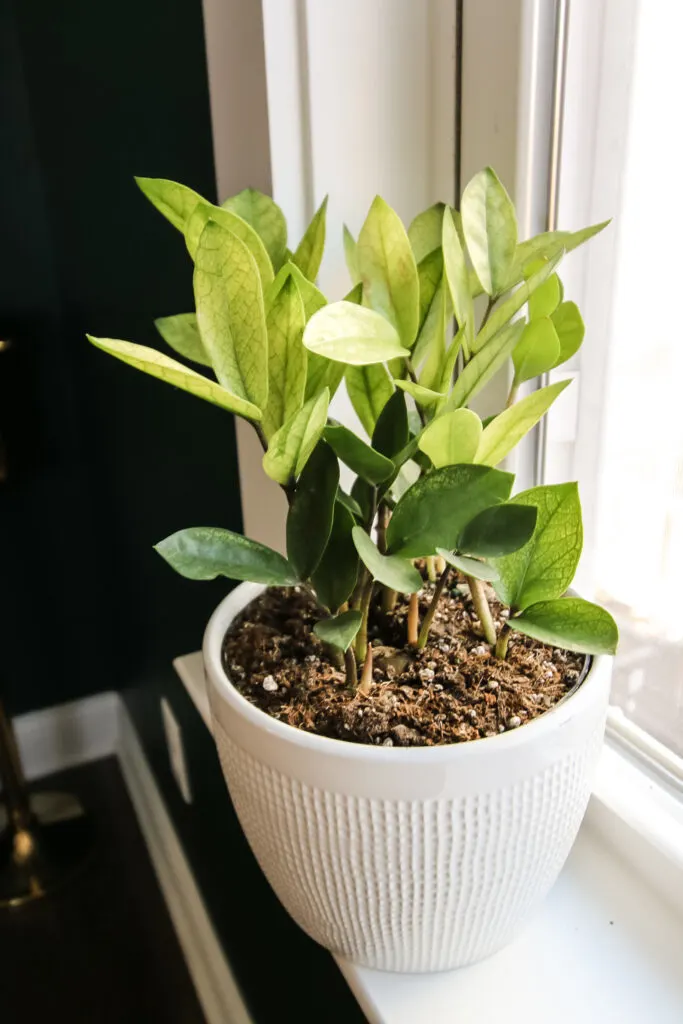
Choose a new pot and add fresh soil
If you managed to save most of your overwatered ZZ plant, re-plant it to a new soil and pot.
Choose the appropriate size and material of a pot for your ZZ plant.
The height of the soil should be 2/3 of the height of the whole plant, and ceramics or terracotta are suitable materials since they allow adequate water evaporation and prevents ZZ plant overwatering.
Whatever pot you choose, be sure that it has drainage holes! This is the best way to prevent pooling water and root rot.
Keep in mind that the replanting must be done in a new pot and with fresh soil. The old soil is most likely made of unsuitable material or has taken in much water, so it’s best to repurpose it for something else.
Another good idea is adding additional nutritional supplements such as orchid bark, coarse sand, coco noir, or peat moss. All these components retain the extra liquid and allow the excess amount to leave the soil.
Most importantly, remember to make drainage holes!
Analyzing the foliage again
Before replanting, check the aerial part of the overwatered ZZ plant once again. Remove the yellowed parts with a blade and sprinkle with cinnamon.
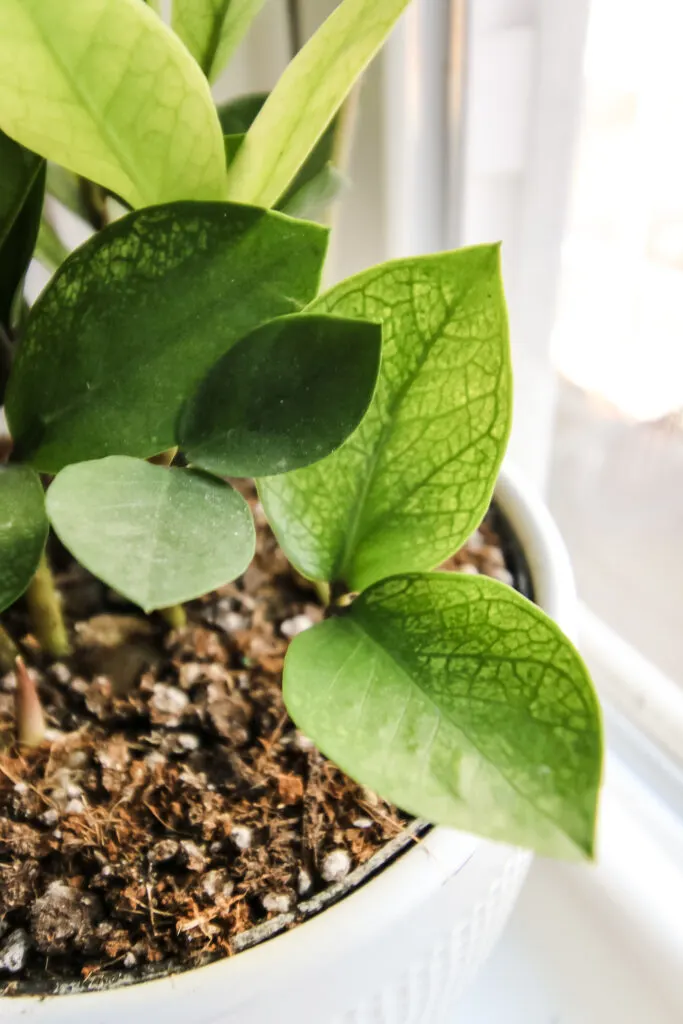
Final touch and further care
At the end of the process, wash your hands and sterilize the area where you worked. This will help to prevent possible pest infestation or spread of rot.
Remember that your ZZ plant is not yet ready to get wet, so refrain from watering it for at least a week.
Once it shows signs that it’s thirsty, take baby steps until you reach the recommended watering intake – once every three weeks.
The same applies to fertilization. Your overwatered ZZ plant has already been through enough – the last thing it needs is overfeeding!
Wait until the next growing season to fertilize it, and be careful how you prepare the fertilizer. If you dilute it too much, your ZZ may receive a lot of water again.
On the other hand, excess fertilizer leads to more significant shocks because the plant will have nowhere to store the nutrients, ultimately becoming a dying ZZ plant.
But now that you know everything about the issue, this won’t even be possible!
As you can see, an overwatered ZZ plant can easily be saved – just remember that you have to be delicate and patient. Use the tips that we provided, and rest assured that your green beauty will thrive in no time!
Any questions about your ZZ plant?
Thanks for reading!


Hey there, I’m Morgan, a houseplant enthusiast from sunny Charleston, South Carolina. Growing up surrounded by my mom’s lush orchids and African violets, I discovered the magic of bringing nature indoors. Thanks to the pandemic, I delved deeper into houseplants, discovering their power to uplift moods and transform spaces. I’m here to spill all my secrets, helping you pick the perfect houseplant – and make it happy. Let’s keep your plants alive, together! 😊
